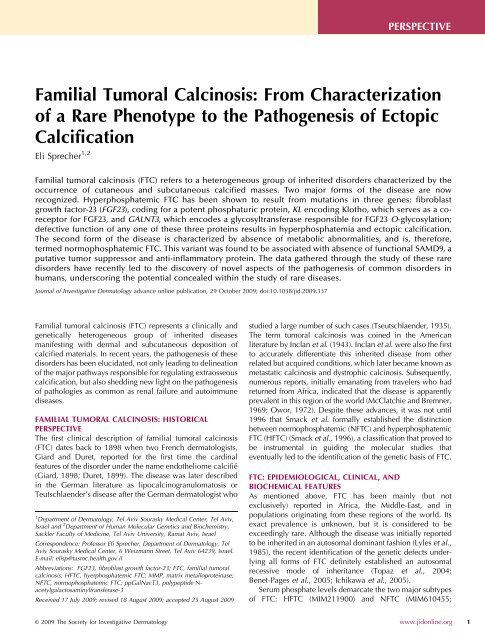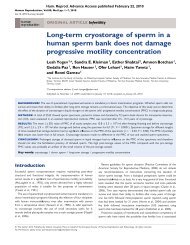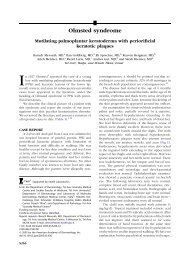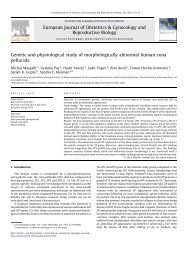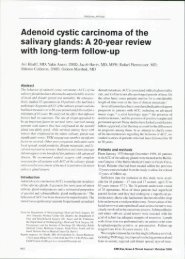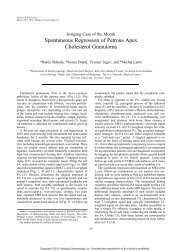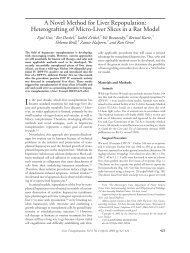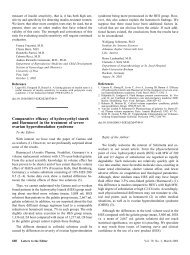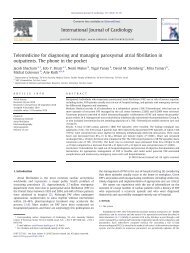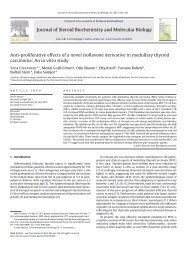Familial Tumoral Calcinosis - Tel-Aviv Sourasky Medical Center ...
Familial Tumoral Calcinosis - Tel-Aviv Sourasky Medical Center ...
Familial Tumoral Calcinosis - Tel-Aviv Sourasky Medical Center ...
Create successful ePaper yourself
Turn your PDF publications into a flip-book with our unique Google optimized e-Paper software.
<strong>Familial</strong> <strong>Tumoral</strong> <strong>Calcinosis</strong>: From Characterization<br />
of a Rare Phenotype to the Pathogenesis of Ectopic<br />
Calcification<br />
Eli Sprecher 1,2<br />
<strong>Familial</strong> tumoral calcinosis (FTC) refers to a heterogeneous group of inherited disorders characterized by the<br />
occurrence of cutaneous and subcutaneous calcified masses. Two major forms of the disease are now<br />
recognized. Hyperphosphatemic FTC has been shown to result from mutations in three genes: fibroblast<br />
growth factor-23 (FGF23), coding for a potent phosphaturic protein, KL encoding Klotho, which serves as a coreceptor<br />
for FGF23, and GALNT3, which encodes a glycosyltransferase responsible for FGF23 O-glycosylation;<br />
defective function of any one of these three proteins results in hyperphosphatemia and ectopic calcification.<br />
The second form of the disease is characterized by absence of metabolic abnormalities, and is, therefore,<br />
termed normophosphatemic FTC. This variant was found to be associated with absence of functional SAMD9, a<br />
putative tumor suppressor and anti-inflammatory protein. The data gathered through the study of these rare<br />
disorders have recently led to the discovery of novel aspects of the pathogenesis of common disorders in<br />
humans, underscoring the potential concealed within the study of rare diseases.<br />
Journal of Investigative Dermatology advance online publication, 29 October 2009; doi:10.1038/jid.2009.337<br />
<strong>Familial</strong> tumoral calcinosis (FTC) represents a clinically and<br />
genetically heterogeneous group of inherited diseases<br />
manifesting with dermal and subcutaneous deposition of<br />
calcified materials. In recent years, the pathogenesis of these<br />
disorders has been elucidated, not only leading to delineation<br />
of the major pathways responsible for regulating extraosseous<br />
calcification, but also shedding new light on the pathogenesis<br />
of pathologies as common as renal failure and autoimmune<br />
diseases.<br />
FAMILIAL TUMORAL CALCINOSIS: HISTORICAL<br />
PERSPECTIVE<br />
The first clinical description of familial tumoral calcinosis<br />
(FTC) dates back to 1898 when two French dermatologists,<br />
Giard and Duret, reported for the first time the cardinal<br />
features of the disorder under the name endotheliome calcifié<br />
(Giard, 1898; Duret, 1899). The disease was later described<br />
in the German literature as lipocalcinogranulomatosis or<br />
Teutschlaender’s disease after the German dermatologist who<br />
1<br />
Department of Dermatology, <strong>Tel</strong> <strong>Aviv</strong> <strong>Sourasky</strong> <strong>Medical</strong> <strong>Center</strong>, <strong>Tel</strong> <strong>Aviv</strong>,<br />
Israel and 2 Department of Human Molecular Genetics and Biochemistry,<br />
Sackler Faculty of Medicine, <strong>Tel</strong> <strong>Aviv</strong> University, Ramat <strong>Aviv</strong>, Israel<br />
Correspondence: Professor Eli Sprecher, Department of Dermatology, <strong>Tel</strong><br />
<strong>Aviv</strong> <strong>Sourasky</strong> <strong>Medical</strong> <strong>Center</strong>, 6 Weizmann Street, <strong>Tel</strong> <strong>Aviv</strong> 64239, Israel.<br />
E-mail: elisp@tasmc.health.gov.il<br />
Abbreviations: FGF23, fibroblast growth factor-23; FTC, familial tumoral<br />
calcinosis; HFTC, hyerphosphatemic FTC; MMP, matrix metalloproteinase;<br />
NFTC, normophosphatemic FTC; ppGalNacT3, polypeptide Nacetylgalactosaminyltransferase-3<br />
Received 17 July 2009; revised 18 August 2009; accepted 25 August 2009<br />
PERSPECTIVE<br />
studied a large number of such cases (Tseutschlaender, 1935).<br />
The term tumoral calcinosis was coined in the American<br />
literature by Inclan et al. (1943). Inclan et al. were also the first<br />
to accurately differentiate this inherited disease from other<br />
related but acquired conditions, which later became known as<br />
metastatic calcinosis and dystrophic calcinosis. Subsequently,<br />
numerous reports, initially emanating from travelers who had<br />
returned from Africa, indicated that the disease is apparently<br />
prevalent in this region of the world (McClatchie and Bremner,<br />
1969; Owor, 1972). Despite these advances, it was not until<br />
1996 that Smack et al. formally established the distinction<br />
between normophosphatemic (NFTC) and hyperphosphatemic<br />
FTC (HFTC) (Smack et al., 1996), a classification that proved to<br />
be instrumental in guiding the molecular studies that<br />
eventually led to the identification of the genetic basis of FTC.<br />
FTC: EPIDEMIOLOGICAL, CLINICAL, AND<br />
BIOCHEMICAL FEATURES<br />
As mentioned above, FTC has been mainly (but not<br />
exclusively) reported in Africa, the Middle-East, and in<br />
populations originating from these regions of the world. Its<br />
exact prevalence is unknown, but it is considered to be<br />
exceedingly rare. Although the disease was initially reported<br />
to be inherited in an autosomal dominant fashion (Lyles et al.,<br />
1985), the recent identification of the genetic defects underlying<br />
all forms of FTC definitely established an autosomal<br />
recessive mode of inheritance (Topaz et al., 2004;<br />
Benet-Pages et al., 2005; Ichikawa et al., 2005).<br />
Serum phosphate levels demarcate the two major subtypes<br />
of FTC: HFTC (MIM211900) and NFTC (MIM610455;<br />
& 2009 The Society for Investigative Dermatology www.jidonline.org 1
E Sprecher<br />
<strong>Familial</strong> <strong>Tumoral</strong> <strong>Calcinosis</strong><br />
Sprecher, 2007). Although these two disorders were initially<br />
considered part of a clinical continuum (Metzker et al.,<br />
1988), it is today clear that they represent distinct entities, not<br />
only at the metabolic level, but also at the clinical,<br />
epidemiological, and genetic (see below) levels.<br />
HFTC is generally characterized by a relatively late onset<br />
from the first to the third decade of life (Prince et al., 1982;<br />
Metzker et al., 1988; Slavin et al., 1993), although<br />
appearance of calcified nodules has been reported as early<br />
as at 6 weeks of age (Polykandriotis et al., 2004). It has been<br />
mainly reported in individuals of Middle Eastern and African<br />
origins (Metzker et al., 1988; Slavin et al., 1993). Many<br />
patients are often incidentally diagnosed while undergoing<br />
radiographic investigation for unrelated reasons. Slowly<br />
growing calcified masses develop mainly at periarticular<br />
locations, with a predilection for skin areas overlying large<br />
joints. The hips are most often involved. These calcified<br />
masses are initially asymptomatic, but progressively reach<br />
large sizes (up to 1.5 kg), thereby interfering with movements<br />
around the joints (Figure 1a). Ulceration is usually accompanied<br />
by intolerable pain and is occasionally associated<br />
with secondary infections, rarely reported as a cause of death<br />
(Sprecher, 2007). In some affected individuals, extracutaneous<br />
signs may predominate. Dental manifestations, including<br />
pulp calcifications and obliteration of the pulp cavity,<br />
may be prominent (Burkes et al., 1991; Campagnoli et al.,<br />
2006; Specktor et al., 2006); testicular microlithiasis has been<br />
reported as part of the disease (Campagnoli et al., 2006);<br />
angioid streaks and corneal calcifications have been observed<br />
as well (Ghanchi et al., 1996); and bone manifestations<br />
(diaphysitis and hyperostosis) may be more common than<br />
initially thought (Clarke et al., 1984; Mallette and Mechanick,<br />
1987; Ballina-Garcia et al., 1996). HFTC has been reported in<br />
association with pseudoxanthoma elasticum (Mallette and<br />
Mechanick, 1987). Recently, a long-term follow-up study of<br />
Figure 1. Clinical findings in FTC. (a) Computed tomographic scan showing<br />
a calcified mass in the soft tissue adjacent to the right major Trochanter<br />
(red arrow). (b) Calcified tumor on the right wrist of a 5-year-old boy with<br />
NFTC. (c) A skin biopsy obtained from an 8-year-old female patient with<br />
NFTC have calcified materials in the upper and middle dermis (hematoxylin<br />
and eosin, 400). (d) Calcified nodules in a 70-year-old patient with<br />
dermatomyositis and acquired calcinosis cutis.<br />
2 Journal of Investigative Dermatology<br />
one of the largest HFTC kindreds described revealed salient<br />
features of the disease, including overall good prognosis, lack<br />
of efficient treatments for the disorder apart from surgical<br />
removal of calcified tumors (most patients undergo over 20<br />
major operations during their life time), and possible association<br />
with hypertension and pulmonary restrictive disease<br />
(Carmichael et al., 2009). <strong>Medical</strong> treatment is notoriously<br />
frustrating. Isolated reports have suggested benefit from<br />
combined treatment of HFTC with acetazolamide and<br />
sevelamer hydrochloride, a non-calcium phosphate binder<br />
(Garringer et al., 2006; Lammoglia and Mericq, 2009).<br />
NFTC seems to be even less prevalent than HFTC, with<br />
only six families reported to date (Topaz et al., 2006; Chefetz<br />
et al., 2008). The disease often initially manifests with a<br />
nonspecific erythematous rash and mucosal inflammation<br />
during the first year of life (Metzker et al., 1988; Katz et al.,<br />
1989). Inflammatory manifestations in the oral cavity can be<br />
particularly debilitating (Gal et al., 1994). This eruption<br />
heralds the progressive, but often rapid, development of<br />
small, acrally located calcified nodules, which almost<br />
invariably lead to ulceration of the overlying skin and<br />
discharge of chalky material (Figure 1b). Here too, unremitting<br />
pain and infection are major causes of morbidity.<br />
Histopathologically (Figure 1c), two major stages in<br />
calcified tumor formation have been recognized: an active<br />
phase characterized by the presence of multinucleated giant<br />
cells and macrophages surrounding calcified deposits in the<br />
dermis, and a chronic or inactive phase associated with dense<br />
fibrous tissue (Veress et al., 1976). Biochemical analysis of<br />
extruded calcified masses indicated that they are mainly<br />
composed of calcium hydroxyapatite with amorphous calcium<br />
carbonate and calcium phosphate (Boskey et al., 1983).<br />
As mentioned above, metabolic abnormalities are the<br />
major features distinguishing HFTC from NFTC. HFTC<br />
patients invariably show elevated levels of circulating<br />
phosphate (in the range of 5 to 7 mg dl 1 , normal<br />
levels ¼ 2.5–4.5 mg dl 1 or 0.80–1.44 mmol), which are due<br />
to decreased fractional phosphate excretion through the<br />
kidney proximal tubules (White et al., 2006). Calcium levels<br />
are typically normal in HFTC, and 1,25-dihydroxyvitamin-D<br />
levels are normal or inappropriately elevated (Steinherz et al.,<br />
1985). In contrast, NFTC patients do not show any metabolic<br />
abnormality (Metzker et al., 1988; Topaz et al., 2006). In fact,<br />
these differences are very much reminiscent of the dichotomous<br />
nature of acquired calcinosis (Touart and Sau, 1998).<br />
Here, calcinosis can either manifest as a result of an<br />
underlying metabolic disorder as in chronic renal failure, or<br />
develop as a reaction to tissue damage, as in autoimmune<br />
diseases (Figure 1d) or as in atherosclerosis (Touart and Sau,<br />
1998). When cutaneous calcinosis is due to deranged<br />
phosphate or calcium metabolism (e.g., chronic renal<br />
failure), it is termed metastatic calcinosis; by contrast, when<br />
it is secondary to tissue damage (e.g., autoimmune disease), it<br />
is known as dystrophic calcinosis (Touart and Sau, 1998). At<br />
this regard, clinical and metabolic features of HFTC very<br />
much resemble metastatic calcinosis, while NFTC models<br />
dystrophic calcinosis, thus suggesting that elucidation of the<br />
molecular basis of FTC may shed light on the pathogenesis of
these two major forms of acquired calcinosis. This assumption<br />
was the impetus that drove a large international effort<br />
aimed at deciphering the molecular cause and biochemical<br />
mechanisms underlying the various forms of FTC.<br />
MOLECULAR GENETICS OF HFTC<br />
We owe to the study of rare diseases the discovery of many<br />
key physiological pathways (Antonarakis and Beckmann,<br />
2006). In less than 5 years, the study of FTC has revealed<br />
a surprisingly intricate regulatory network of proteins<br />
responsible for regulation of phosphate homeostasis and<br />
extraosseous calcification (Sprecher, 2007; Chefetz and<br />
Sprecher, 2009).<br />
Using homozygosity mapping, HFTC was initially mapped<br />
to 2q24–q31 and found to be associated with mutations in<br />
GALNT3, gene encoding a glycosyltransferase termed UDP-<br />
N-acetyl-a-D-galactosamine-polypeptide N-acetylgalactosaminyltransferase-3<br />
(ppGalNacT3; Topaz et al., 2004). ppGal-<br />
NacT3 catalyses the initial step of O-glycosylation of serine<br />
and threonine residues, and is ubiquitously expressed<br />
(Ten Hagen et al., 2003; Wopereis et al., 2006). ppGalNacT3<br />
is one of a family of 24 acetylgalactosaminyltransferases,<br />
which are expressed in a tissue-specific manner and play an<br />
important role in the development and maintenance of a<br />
variety of tissues (Ten Hagen et al., 2003). Most congenital<br />
disorders of glycosylation result from impaired N-glycosylation<br />
and are characterized by pleiotropic clinical manifestations<br />
(Freeze, 2006); in this regard, HFTC is unique in that it<br />
results from abnormal O-glycosylation and seems to be<br />
associated exclusively with ectopic calcification.<br />
More than 10 mutations have so far been reported in<br />
GALNT3 (Topaz et al., 2004; Ichikawa et al., 2005, 2006;<br />
Campagnoli et al., 2006; Garringer et al., 2006, 2007;<br />
Specktor et al., 2006; Barbieri et al., 2007; Dumitrescu et al.,<br />
2009; Laleye et al., 2008); all of these are predicted or have<br />
been found (Topaz et al., 2005) to result in loss of function of<br />
ppGalNacT3. Deleterious alterations in GALNT3 were also<br />
found to underlie at least one additional autosomal recessive<br />
syndrome, hyperostosis–hyperphosphatemia syndrome<br />
(MIM610233), which, as HFTC, is also associated with<br />
elevated levels of serum phosphate (Melhem et al., 1970;<br />
Altman and Pomerance, 1971; Mikati et al., 1981). This<br />
syndrome manifests with episodes of excruciating pain<br />
associated with swelling, along the long bones. Despite the<br />
fact that HFTC and hyperostosis–hyperphosphatemia syndrome<br />
manifest phenotypically in two different tissues, skin<br />
and bone, mutations in the same gene, GALNT3, and in one<br />
instance, the very same mutation (Frishberg et al., 2005),<br />
were found to underlie both syndromes (Ichikawa et al.,<br />
2007a; Dumitrescu et al., 2009; Olauson et al., 2008; Gok<br />
et al., 2009). Interestingly, coexistence of the two diseases in<br />
one family has been reported (Narchi, 1997; Nithyananth<br />
et al., 2008). In fact, phenotypic heterogeneity seems to be<br />
quite characteristic of the HFTC group of diseases, with a<br />
widely variable spectrum of disease severity and tissue<br />
involvement (Sprecher, 2007).<br />
Large-scale screening of HFTC families revealed that<br />
GALNT3 mutations cannot be found in all HFTC families.<br />
E Sprecher<br />
<strong>Familial</strong> <strong>Tumoral</strong> <strong>Calcinosis</strong><br />
In parallel, several groups noticed that HFTC represents in<br />
many ways the metabolic mirror image of another rare<br />
disorder known as hypophosphatemic rickets (Bastepe and<br />
Juppner, 2008). Three genetic types of hypophosphatemic<br />
rickets have been described: X-linked, autosomal recessive,<br />
and autosomal dominant hypophosphatemic rickets, which<br />
were shown to be caused by mutations in PHEX, DMP1, and<br />
fibroblast growth factor-23 (FGF23), respectively (Juppner,<br />
2007; Bastepe and Juppner, 2008; Shaikh et al., 2008).<br />
FGF23 encodes the FGF23, a potent phosphaturic protein<br />
responsible for promoting phosphate excretion through<br />
kidney (Strom and Juppner, 2008). DMP1 and PHEX function<br />
as negative regulators of the activity of FGF23 (Quarles,<br />
2008). FGF23 mainly originates from mineralized tissues,<br />
although it has also been detected in other tissues such as<br />
kidneys, liver, and brain (Yoshiko et al., 2007). Recent data<br />
indicate that FGF23 signals through the FGFR1(IIIc) receptor,<br />
which is converted into a functional FGF23 receptor by<br />
Klotho (Urakawa et al., 2006), a molecule previously shown<br />
in mice to regulate aging-related processes (Kurosu and<br />
Kuro-o, 2008). Despite the fact that activating mutations in<br />
FGFR3 have been linked to hypophosphatemia (Quarles,<br />
2008), it seems that this receptor does not mediate the renal<br />
effects of FGF23 (Liu et al., 2008).<br />
Assessment of HFTC patients without GALNT3 mutations<br />
revealed that while dominant gain-of-function mutations in<br />
FGF23 result in hypophosphatemic rickets, recessive loss-offunction<br />
mutations in the same gene cause HFTC (Araya<br />
et al., 2005; Benet-Pages et al., 2005; Chefetz et al., 2005;<br />
Larsson et al., 2005b; Lammoglia and Mericq, 2009; Masi<br />
et al., 2009). HFTC-causing mutations in FGF23 are<br />
associated with a variety of biochemical abnormalities such<br />
as abnormal secretion of the intact molecule from the Golgi<br />
(Benet-Pages et al., 2005) and decreased FGF23 stability<br />
(Larsson et al., 2005a; Garringer et al., 2008).<br />
FGF23 activity is partially processed intracellularly by<br />
subtilisin-like proprotein convertases at a consensus sequence<br />
between residues R179 and S180 (Benet-Pages<br />
et al., 2004). Dominant mutations associated with hypophosphatemic<br />
rickets affect the proteolytic site of FGF23,<br />
preventing proper degradation of the molecule (Shimada<br />
et al., 2002). In contrast, HFTC-causing mutations in FGF23<br />
have been shown to result in enhanced proteolytic processing<br />
of FGF23 (Larsson et al., 2005a; Garringer et al., 2008). In<br />
addition, a recent study showed that a missense mutation in<br />
KL, encoding Klotho, also results in a phenotype very much<br />
resembling HFTC (Ichikawa et al., 2007b). This mutation was<br />
found to result in decreased expression of Klotho and<br />
concomitant decreased FGF23 signaling, leading to a severe<br />
form of HFTC characterized by widespread cutaneous and<br />
visceral calcifications, diffuse osteopenia, and sclerodactyly<br />
(Ichikawa et al., 2007b).<br />
PATHOGENESIS OF HFTC<br />
In summary, (1) HFTC can be caused by mutations in at least<br />
three genes (GALNT3, FGF23, and KL); (2) loss-of-function<br />
sequence alterations in GALNT3 are associated with two<br />
distinct phenotypes, HFTC and HSS; and (3) loss-of-function<br />
www.jidonline.org 3
E Sprecher<br />
<strong>Familial</strong> <strong>Tumoral</strong> <strong>Calcinosis</strong><br />
Table 1. Genetic and phenotypic heterogeneity among disorders of phosphate metabolism associated with<br />
abnormal ppGalNacT3 and FGF23 function<br />
Disease OMIM Phenotype Gene (protein) Protein function<br />
Hyperphosphatemic familial<br />
tumoral calcinosis<br />
Hyperostosis<br />
hyperphosphatemia<br />
syndrome<br />
Hyperphosphatemic familial<br />
tumoral calcinosis<br />
Autosomal dominant<br />
hypophosphatemic rickets<br />
Hyperphosphatemic familial<br />
tumoral calcinosis<br />
X-linked hypophosphatemic<br />
rickets<br />
Autosomal recessive<br />
hypophosphatemic rickets<br />
Epidermal nevus 1<br />
211900 Calcified masses over large joints, occasionally<br />
visceral calcifications<br />
610233 Repeated attacks of painful swellings of the long<br />
bones; on radiography, cortical hyperostosis,<br />
periosteal reaction, diaphysitis<br />
211900 Calcified masses over large joints, more frequent<br />
visceral calcifications than with GALNT3 mutations<br />
mutations in FGF23 also cause HFTC, while dominant gainof-function<br />
mutations in the same gene are associated with<br />
hypophosphatemic rickets (2000), which is also due to<br />
mutations in DMP1 (Feng et al., 2006; Lorenz-Depiereux<br />
et al., 2006) and PHEX (Table 1 and Strom and Juppner,<br />
2008). These findings raised the possibility that these various<br />
molecules may be part of a single physiological pathway.<br />
Recent data lend support to this hypothesis (Figure 2).<br />
For decades, phosphate homeostasis has been thought to<br />
be maintained through concerted actions of parathyroid<br />
hormone, which inhibits renal phosphate reabsorption and<br />
mobilizes bone calcium and phosphate, and 1,25-hydroxyvitamin-D,<br />
which increases phosphate transport across<br />
small intestine (Schiavi and Moe, 2002; Quarles, 2008). More<br />
recently, a group of proteins, known as phosphatonins, has<br />
been shown to regulate phosphate levels in the circulation<br />
independently of calcium (Schiavi and Moe, 2002). FGF23 is<br />
the phosphatonin that has been best characterized so far.<br />
As mentioned above, FGF23 signaling is dependent on the<br />
presence of Klotho (Kurosu and Kuro, 2009). Thus FGF23<br />
mainly targets organs expressing Klotho such as parathyroid<br />
glands and kidneys (Razzaque and Lanske, 2007).<br />
FGF23 inhibits phosphate reabsorption through the major<br />
sodium-phosphate transporters, NaPi-IIa and NaPi-IIc, thus<br />
allowing efficient counter-regulation of excessive circulating<br />
levels of phosphate (Saito et al., 2003; Razzaque, 2009).<br />
FGF23 also suppresses CYP27B1, which catalyzes 1-ahydroxylation<br />
of 25-hydroxy-vitamin-D and activates<br />
CYP24, which inactivates 1,25-hydroxyvitamin-D (Liu and<br />
Quarles, 2007). Interestingly, 1,25-dihydroxyvitamin-D was<br />
GALNT3<br />
(ppGalNacT3)<br />
GALNT3<br />
(ppGalNacT3)<br />
Initiates mucin type<br />
O-glycosylation<br />
Initiates mucin type<br />
O-glycosylation<br />
FGF23 (FGF23) Regulates phosphate<br />
reabsorption<br />
193100 Growth retardation, osteomalacia, rickets, bone pain FGF23 (FGF23) Regulates phosphate<br />
reabsorption<br />
211900 Widespread cutaneous and visceral calcifications,<br />
diffuse osteopenia and sclerodactyly<br />
KL (Klotho) Involved in the regulation of<br />
phosphate and calcium levels<br />
307800 Growth retardation, osteomalacia, rickets, bone pain PHEX (PHEX) Protease, which regulates<br />
FGF23 expression and bone<br />
mineralization<br />
241520 Growth retardation, osteomalacia, rickets, bone pain DMP1 (DMP1) Regulates FGF23 expression<br />
and bone mineralization<br />
162900 Hyperkeratotic papules/plaques distributed in a linear<br />
or segmental fashion<br />
FGFR3 (FGFR3) Serves as receptor for fibroblast<br />
growth factors such as FGF1<br />
FGF23, fibroblast growth factor-23; ppGalNacT3, polypeptide N-acetylgalactosaminyltransferase-3.<br />
1<br />
In selected cases of epidermal nevus, increased levels of FGF23 associated with hypophosphatemic rickets are observed due to end-organ gain-of-function<br />
mutations.<br />
4 Journal of Investigative Dermatology<br />
found to upregulate FGF23 expression in bone, thereby<br />
establishing a novel endocrine feedback loop between these<br />
two hormones (Kolek et al., 2005; Saito et al., 2005). Not<br />
only does FGF23 deficiency alter phosphate homeostasis, it<br />
also leads to abnormal mineralization, suggesting that FGF23<br />
plays a role in bone formation (Sitara et al., 2008), perhaps in<br />
a paracrine manner since osteocytes in bone are the major<br />
source of FGF23 (Yoshiko et al., 2007). The clinical<br />
phenotype associated with decreased Klotho activity very<br />
much overlaps with that exhibited by FGF23-deficient<br />
individuals, except for the fact that HFTC caused by KL<br />
mutations is associated with hypercalcemia as well as<br />
elevated serum levels of parathyroid hormone and FGF23<br />
(Ichikawa et al., 2007b). This may in fact relate to the fact that<br />
Klotho plays major direct (e.g., regulation of the secretion of<br />
the parathyroid hormone) and indirect (e.g., decreased 1,25dihydroxyvitamin-D<br />
3 activity) roles in the maintenance of<br />
calcium homeostasis (Nabeshima and Imura, 2008). Of note,<br />
independently of regulation of phosphate and calcium<br />
homeostasis, Klotho plays a number of other important roles<br />
such as controlling insulin signaling (Razzaque and Lanske,<br />
2007; Kurosu and Kuro-o, 2008; Nabeshima and Imura,<br />
2008). Taken altogether, these data suggest that FGF23<br />
mainly serves as a counter-regulatory hormone to offset the<br />
effect of excessive 1,25-hydroxy-vitamin-D.<br />
As mentioned above, activity of FGF23 is mainly<br />
modulated by a poorly understood process of proteolysis at<br />
a furin-like convertase sequence motif. PHEX and DMP1<br />
may promote the activity of the subtilisin-like protease(s)<br />
responsible for mediating FGF23 cleavage (Quarles, 2008).
14<br />
16<br />
BONE<br />
INTESTINE<br />
11<br />
10<br />
GALNT3<br />
1<br />
ppGalNacT3 O-glycosylation<br />
3<br />
[Pi]<br />
13<br />
17<br />
DMP1 PHEX<br />
FGF23<br />
FGF23<br />
More interestingly, FGF23 was found to be a substrate for<br />
ppGalNacT3-mediated O-glycosylation. ppGalNacT3 was<br />
found to catalyze the glycosylation of the recognition site of<br />
subtilisin-like proprotein convertase, thereby protecting<br />
FGF23 from proteolysis (Kato et al., 2006). FGF23 secretion<br />
was also found to be dependent on ppGalNacT3-mediated<br />
O-glycosylation (Kato et al., 2006). Thus, since loss-offunction<br />
mutations in GALNT3, FGF23, and KL all result in<br />
decreased activity of FGF23, it is not surprising that they also<br />
yield overlapping phenotypes (Table 1).<br />
Currently very little is known about the factors regulating<br />
the expression of GALNT3. Phosphate was found to stimulate<br />
the expression and/or activity of ppGalNacT3 (Chefetz et al.,<br />
2009) as well as FGF23 (Saito et al., 2005), while it induced a<br />
5<br />
SPC<br />
VitD<br />
FGF7<br />
6<br />
12<br />
Phosphate<br />
re-absorption<br />
18<br />
Parathyroid glands<br />
9<br />
20<br />
2<br />
8<br />
KIDNEY<br />
MMPs<br />
<strong>Calcinosis</strong> cutis<br />
4<br />
KLOTHO<br />
Figure 2. FTC-associated molecules and the regulation of phosphate<br />
homeostasis. Two genes have been found to be associated with classical FTC,<br />
GALNT3 encoding ppGalNacT3 (1) and FGF23 encoding the phosphatonin<br />
FGF23 (2). Increased phosphate levels upregulate the activity of ppGAlNacT3<br />
(3) as well as FGF23 (4). ppGalNacT3 then O-glycosylates FGF23 (5), thereby<br />
protecting it from the proteolytic activity of subtilisin-like proprotein<br />
convertases (SPC) (6). FGF23 then signals through its receptor in the presence of<br />
Klotho (7), resulting in decreased transport of phosphate through the Na–Pi<br />
transporters (8) and inhibiting vitamin-D1 hydroxylation (9). Since 1,25dihydroxyvitamin-D<br />
acts by promoting phosphate absorption through the small<br />
intestine (10), the effect of FGF23 on vitamin-D metabolism results in decreased<br />
entry of phosphate into the circulation (11). In contrast, 1,25-dihydroxyvitamin-<br />
D augments FGF23 signaling (12), but inhibits ppGalNacT3 expression (13),<br />
thereby establishing a double-regulatory feedback loop mechanism. Of note,<br />
FGF23 influences bone mineralization (14). The entire system is also under the<br />
regulation of parathyroid hormone, which promotes phosphate excretion<br />
through kidney (15) and mobilizes phosphate from the bone (16), thus<br />
integrating calcium- and phosphate-regulatory systems. As a consequence of<br />
hyperphosphatemia, FGF7 is induced (17), which results in expression and<br />
activation of several MMPs (18), which are known to mediate ectopic<br />
calcification (19). Since FGF7 mainly originates from the dermis, this may<br />
explain the propensity of ectopic calcification to develop in the skin in HFTC.<br />
Additional elements involved in the regulation of FGF23 activity include PHEX<br />
and DMP1, which inhibit FGF23 activity through still poorly understood<br />
mechanisms (possibly including a direct interaction between them) (20). Lossof-function<br />
mutations in the genes encoding these two molecules are<br />
associated with increased FGF23 activity and hypophosphatemia.<br />
7<br />
15<br />
19<br />
E Sprecher<br />
<strong>Familial</strong> <strong>Tumoral</strong> <strong>Calcinosis</strong><br />
marked decrease in the activity of 1-a-hydroxylase, thereby<br />
decreasing the amount of active vitamin-D 3 (Perwad et al.,<br />
2005). Since 1,25-dihydroxyvitamin-D was shown to decrease<br />
the expression of GALNT3 (Chefetz et al., 2009), this<br />
complex feedback loop enables for restraining the activity of<br />
FGF23 once it is no more required, namely when phosphate<br />
level is back to normal.<br />
A major question, which remained largely unanswered, is<br />
why does HFTC-associated ectopic calcification mainly<br />
affect cutaneous and subcutaneous tissues in the face of<br />
hyperphosphatemia affecting equally all tissues. Recent data<br />
have implicated FGF7, another phosphatonin, which is<br />
secreted in response to hyperphosphatemia (characteristically<br />
found in HFTC; Carpenter et al., 2005), is produced<br />
exclusively in the dermis (auf demKeller et al., 2004), and<br />
is capable of triggering the activation of matrix metalloproteinases<br />
(MMPs; Putnins et al., 1995; Shin et al., 2002; Simian<br />
et al., 2001). Interestingly, MMPs have been shown to<br />
mediate ectopic calcification in vascular tissues (Satta et al.,<br />
2003; Qin et al., 2006). Accordingly, fibroblasts derived from<br />
HFTC patients or normal fibroblasts knocked down for<br />
GALNT3 showed increased activation of several key MMPs<br />
(Chefetz et al., 2009).<br />
MOLECULAR GENETICS OF NFTC<br />
The fact that NFTC has so far been reported exclusively<br />
among Yemenite Jews suggested that a founder mutation may<br />
underlie the disease in this community, which in turn<br />
allowed homozygosity mapping to be used to locate the<br />
disease gene. Through study of five affected kindreds, the<br />
disease gene was found to map to 7q21, confirming at the<br />
genetic level the fact that NFTC and HFTC (which maps to<br />
2q) are two separate non-allelic disorders, despite clinical<br />
similarities between them (Topaz et al., 2006). Candidate<br />
gene screening revealed initially a missense mutation in<br />
SAMD9 segregating with the disease phenotype in all families<br />
(Topaz et al., 2006). The mutation was found to result in<br />
SAMD9 protein degradation, suggesting a loss-of-function<br />
effect (Topaz et al., 2006). In agreement with these results, a<br />
second nonsense mutation was later identified in an<br />
additional kindred of Jewish Yemenite origin (Chefetz et al.,<br />
2008). Although at first, identification of two mutations in<br />
SAMD9 causing a similar phenotype may have been<br />
expected, these data are surprising given the rarity of the<br />
disease and the very small size of the Jewish Yemenite<br />
population. In fact, the occurrence of two independent<br />
genetic events within a very close and small population may<br />
reflect a selection effect (Chefetz et al., 2008). Unfortunately,<br />
very little is currently known about the physiological function<br />
of SAMD9 so that no functional rationale has been provided<br />
so far to explain this effect.<br />
PATHOGENESIS OF NFTC<br />
SAMD9 is a 1,589-amino-acid cytoplasmic protein ubiquitously<br />
expressed in all adult and fetal tissues except for fetal<br />
brain and skeletal muscle (Topaz et al., 2006; Li et al., 2007).<br />
Apart from an N-terminal SAM domain, it lacks homology to<br />
any known family of proteins.<br />
www.jidonline.org 5
E Sprecher<br />
<strong>Familial</strong> <strong>Tumoral</strong> <strong>Calcinosis</strong><br />
The fact that calcification in NFTC is often preceded by an<br />
inflammatory rash (Metzker et al., 1988; Katz et al., 1989)<br />
suggests a role for SAMD9 in the regulation of inflammation<br />
within the skin. In line with this hypothesis, tumor necrosis<br />
factor-a as well as osmotic shock were found to induce<br />
SAMD9 expression in a p38- and NF-kB-dependant manner<br />
(Chefetz et al., 2008). This indicates that SAMD9 may be<br />
involved in tumor necrosis factor-a-induced cell apoptosis. It<br />
is, therefore, of interest to note that the expression of SAMD9<br />
was found to be significantly downregulated in a large<br />
proportion of tumors of various origins (Li et al., 2007).<br />
Decreased expression of SAMD9 was found to be associated<br />
with increased cell proliferation and decreased apoptosis (Li<br />
et al., 2007). In addition, transfection of tumor cells with<br />
SAMD9 was accompanied by increased apoptotic activity,<br />
decreased cell invasion in an in vitro assay, and decreased<br />
cancer cell proliferation (Li et al., 2007). Tumor cells<br />
overexpressing SAMD9 formed tumor of a lower volume as<br />
compared with wild-type cells (Li et al., 2007). Altogether,<br />
these data indicate that SAMD9 may function as a tumorsuppressor<br />
gene. In support of this hypothesis, recent data<br />
show that myelodysplatic syndrome, acute myeloid leukemia,<br />
and juvenile myelomonocytic leukemia are associated<br />
with a microdeletion on 7q21.3 spanning SAMD9, and its<br />
paralog, SAMD9 L (Asou et al., 2009). How are these two<br />
putative functions of SAMD9 (anti-inflammatory and tumorsuppressive)<br />
mechanistically related is not yet known.<br />
RELEVANCE TO ACQUIRED DISEASES<br />
The data reviewed above indicate the importance of<br />
ppGalNacT3, FGF23, Klotho, and SAMD9 in the prevention<br />
of abnormal calcification in peripheral tissues. Their involvement<br />
in the pathogenesis of relevant human pathologies is<br />
currently the focus of intense research efforts.<br />
A growing body of evidence points to extraosseous<br />
calcification as a major cause or predictor of morbidity and<br />
mortality in humans. Vascular calcification has been shown<br />
to quite accurately predict mortality, mainly due to cardiovascular<br />
causes, in large cohorts (Thompson and Partridge,<br />
2004; Barasch et al., 2006). Among factors that have been<br />
known for long to be associated with the propensity to<br />
develop cardiovascular diseases, are elevated levels of<br />
circulating phosphate (Kestenbaum et al., 2005; Tonelli<br />
et al., 2005; Giachelli, 2009), which has been shown to<br />
induce ectopic calcification (Jono et al., 2000). Hyperphosphatemia<br />
is most likely acting independently of more<br />
conventional cardiovascular risk factors (Lippi et al., 2009),<br />
suggesting that interventions specifically directed at attenuating<br />
extraosseous calcification may provide substantial additional<br />
benefit to individuals at risk (Schmitt et al., 2006).<br />
Several studies have asked whether the newly discovered<br />
regulators of phosphate homeostasis have a predictive value<br />
of their own for pathologies known to be associated with<br />
elevated levels of circulating phosphate. Although FGF23<br />
levels were found to also correlate with mortality among<br />
patients undergoing hemodialysis, total-body atherosclerosis<br />
in the general population, and progression of chronic renal<br />
disease, they were found to predict outcome independently<br />
6 Journal of Investigative Dermatology<br />
of phosphate levels (Fliser et al., 2007; Gutierrez et al., 2008;<br />
Mirza et al., 2009); in contrast, FGF23 levels were found to<br />
be associated with renal stone formation only if due to<br />
increased urinary excretion of phosphate (Rendina et al.,<br />
2006).<br />
These data suggest a potential benefit for novel therapies<br />
based on modulation of the activity of the various molecules<br />
known to play a role in the pathogenesis of inherited FTC.<br />
Tetracyclines have been shown to ameliorate the course of<br />
ectopic calcinosis (Robertson et al., 2003; Boulman et al.,<br />
2005) as well as to inhibit the activity of MMPs (Kim et al.,<br />
2005; Qin et al., 2006), which may play a role in the<br />
pathogenesis of FTC (Chefetz et al., 2009). Interestingly, we<br />
were recently able to show that doxycycline significantly<br />
upregulates the expression of ppGalNacT3 (Chefetz and<br />
Sprecher, 2009), suggesting the need to assess the efficacy of<br />
tetracyclines in disorders associated with deranged activity of<br />
the ppGalNacT3–FGF23 axis.<br />
CONCLUSIONS<br />
The study of FTC phenotypes has led to delineation of novel<br />
biochemical pathways of importance for maintenance of<br />
phosphate balance. It exemplifies remarkably the immense<br />
potential concealed within the study of rare diseases, for only<br />
through the study of human subjects could the function of<br />
ppGalNacT3, FGF23, and Klotho have been delineated.<br />
Indeed, although ppGalNacT3-deficient mice feature a<br />
normal lifespan, show hyperphosphatemia, and inappropriately<br />
normal levels of 1,25-dihydroxyvitamin-D 3, in analogy<br />
with what is seen in HFTC patients, the mice do not show<br />
ectopic calcifications and males are infertile, which are not<br />
features of HFTC in humans (Ichikawa et al., 2009). In<br />
contrast to humans, FGF23-deficient mice have a shortened<br />
lifespan and show growth retardation, infertility, muscle<br />
atrophy, hypoglycemia, and visceral calcification (Kuro-o<br />
et al., 1997; Shimada et al., 2004). In fact FGF23 mice<br />
resemble very much Klotho-deficient mice (Kuro-o et al.,<br />
1997), even though Klotho deficiency manifests differently in<br />
humans than FGF23 deficiency (Ichikawa et al., 2007b).<br />
More interestingly, SAMD9 does not exist at all in the murine<br />
genome (Li et al., 2007). Thus, through study of an<br />
exceedingly rare phenotype the major regulatory molecules<br />
of critical importance for maintenance of phosphate homeostasis<br />
and prevention of ectopic calcification have been<br />
discovered and are on the verge of being used to refine<br />
therapeutic approaches to much more common ailments in<br />
humans such as renal failure and autoimmune diseases.<br />
CONFLICT OF INTEREST<br />
The authors state no conflict of interest.<br />
ACKNOWLEDGMENTS<br />
I am grateful to the patients and their families for participation in our studies.<br />
I also thank our many collaborators, including Orit Topaz, Ilana Chefetz,<br />
Dov Hershkovitz, Gabriele Richard, Margarita Indelman, Aryeh Metzker, Ulla<br />
Mandel, Mordechai Mizrachi, John G Cooper, Polina Specktor, Vered<br />
Friedman, Gila Maor, Israel Zelikovic, Sharon Raimer, Yoram Altschuler,<br />
Mordechai Choder, Dani Bercovich, Jouni Uitto, and Reuven Bergman, for<br />
their invaluable contribution to the various studies reviewed above. I also
thank Dr Dorit Goldsher (Rambam Health Care campus) for providing a<br />
picture of a computed tomographic scan in HFTC. This work was supported in<br />
part by grants provided by the Israel Science Foundation, the Israel Ministry of<br />
Health, and NIH/NIAMS grant R01 AR052627.<br />
REFERENCES<br />
Altman HS, Pomerance HH (1971) Cortical hyperostosis with hyperphosphatemia.<br />
J Pediatr 79:874–5<br />
Antonarakis SE, Beckmann JS (2006) Mendelian disorders deserve more<br />
attention. Nat Rev Genet 7:277–82<br />
Araya K, Fukumoto S, Backenroth R, Takeuchi Y, Nakayama K, Ito N et al.<br />
(2005) A novel mutation in fibroblast growth factor 23 gene as a cause of<br />
tumoral calcinosis. J Clin Endocrinol Metab 90:5523–7<br />
Asou H, Matsui H, Ozaki Y, Nagamachi A, Nakamura M, Aki D et al. (2009)<br />
Identification of a common microdeletion cluster in 7q21.3 subband<br />
among patients with myeloid leukemia and myelodysplastic syndrome.<br />
Biochem Biophys Res Commun 383:245–51<br />
auf demKeller U, Krampert M, Kumin A, Braun S, Werner S (2004)<br />
Keratinocyte growth factor: effects on keratinocytes and mechanisms<br />
of action. Eur J Cell Biol 83:607–12<br />
Ballina-Garcia FJ, Queiro-Silva R, Fernandez-Vega F, Fernandez-Sanchez JA,<br />
Weruaga-Rey A, Perez-Del Rio MJ et al. (1996) Diaphysitis in tumoral<br />
calcinosis syndrome. J Rheumatol 23:2148–51<br />
Barasch E, Gottdiener JS, Marino Larsen EK, Chaves PH, Newman AB (2006)<br />
Cardiovascular morbidity and mortality in community-dwelling elderly<br />
individuals with calcification of the fibrous skeleton of the base of the<br />
heart and aortosclerosis (The Cardiovascular Health Study). Am J Cardiol<br />
97:1281–6<br />
Barbieri AM, Filopanti M, Bua G, Beck-Peccoz P (2007) Two novel nonsense<br />
mutations in GALNT3 gene are responsible for familial tumoral<br />
calcinosis. J Hum Genet 52:464–8<br />
Bastepe M, Juppner H (2008) Inherited hypophosphatemic disorders in<br />
children and the evolving mechanisms of phosphate regulation. Rev<br />
Endocr Metab Disord 9:171–80<br />
Benet-Pages A, Lorenz-Depiereux B, Zischka H, White KE, Econs MJ, Strom<br />
TM (2004) FGF23 is processed by proprotein convertases but not by<br />
PHEX. Bone 35:455–62<br />
Benet-Pages A, Orlik P, Strom TM, Lorenz-Depiereux B (2005) An FGF23<br />
missense mutation causes familial tumoral calcinosis with hyperphosphatemia.<br />
Hum Mol Genet 14:385–90<br />
Boskey AL, Vigorita VJ, Sencer O, Stuchin SA, Lane JM (1983) Chemical,<br />
microscopic, and ultrastructural characterization of the mineral deposits<br />
in tumoral calcinosis. Clin Orthop Relat Res 178:258–69<br />
Boulman N, Slobodin G, Rozenbaum M, Rosner I (2005) <strong>Calcinosis</strong> in<br />
rheumatic diseases. Semin Arthritis Rheum 34:805–12<br />
Burkes EJ Jr, Lyles KW, Dolan EA, Giammara B, Hanker J (1991) Dental<br />
lesions in tumoral calcinosis. J Oral Pathol Med 20:222–7<br />
Campagnoli MF, Pucci A, Garelli E, Carando A, Defilippi C, Lala R et al.<br />
(2006) <strong>Familial</strong> tumoral calcinosis and testicular microlithiasis associated<br />
with a new mutation of GALNT3 in a White family. J Clin Pathol<br />
59:440–2<br />
Carmichael KD, Bynum JA, Evans EB (2009) <strong>Familial</strong> tumoral calcinosis: a<br />
forty-year follow-up on one family. J Bone Joint Surg Am 91:664–71<br />
Carpenter TO, Ellis BK, Insogna KL, Philbrick WM, Sterpka J, Shimkets R<br />
(2005) Fibroblast growth factor 7: an inhibitor of phosphate transport<br />
derived from oncogenic osteomalacia-causing tumors. J Clin Endocrinol<br />
Metab 90:1012–20<br />
Chefetz I, Ben Amitai D, Browning S, Skorecki K, Adir N, Thomas MG et al.<br />
(2008) Normophosphatemic familial tumoral calcinosis is caused by<br />
deleterious mutations in SAMD9, encoding a TNF-alpha responsive<br />
protein. J Invest Dermatol 128:1423–9<br />
Chefetz I, Heller R, Galli-Tsinopoulou A, Richard G, Wollnik B, Indelman M<br />
et al. (2005) A novel homozygous missense mutation in FGF23 causes<br />
familial tumoral calcinosis associated with disseminated visceral<br />
calcification. Hum Genet 118:261–6<br />
E Sprecher<br />
<strong>Familial</strong> <strong>Tumoral</strong> <strong>Calcinosis</strong><br />
Chefetz I, Kohno K, Izumi H, Uitto J, Richard G, Sprecher E (2009) GALNT3, a<br />
gene associated with hyperphosphatemic familial tumoral calcinosis, is<br />
transcriptionally regulated by extracellular phosphate and modulates<br />
matrix metalloproteinase activity. Biochim Biophys Acta 1792:61–7<br />
Chefetz I, Sprecher E (2009) <strong>Familial</strong> tumoral calcinosis and the role of Oglycosylation<br />
in the maintenance of phosphate homeostasis. Biochim<br />
Biophys Acta 1792:847–52<br />
Clarke E, Swischuk LE, Hayden CK Jr (1984) <strong>Tumoral</strong> calcinosis, diaphysitis,<br />
and hyperphosphatemia. Radiology 151:643–6<br />
Dumitrescu CE, Kelly MH, Khosravi A, Hart TC, Brahim J, White KE et al.<br />
(2009) A case of familial tumoral calcinosis/hyperostosis–hyperphosphatemia<br />
syndrome due to a compound heterozygous mutation in<br />
GALNT3 demonstrating new phenotypic features. Osteoporos Int<br />
20:1273–8<br />
Duret MH (1899) Tumeurs multiples and singuliers de bourses sereuses. Bull<br />
Mem Soc Ant 74: 725–31<br />
Feng JQ, Ward LM, Liu S, Lu Y, Xie Y, Yuan B et al. (2006) Loss of DMP1<br />
causes rickets and osteomalacia and identifies a role for osteocytes in<br />
mineral metabolism. Nat Genet 38:1310–5<br />
Fliser D, Kollerits B, Neyer U, Ankerst DP, Lhotta K, Lingenhel A et al. (2007)<br />
Fibroblast growth factor 23 (FGF23) predicts progression of chronic<br />
kidney disease: the Mild to Moderate Kidney Disease (MMKD) Study.<br />
J Am Soc Nephrol 18:2600–8<br />
Freeze HH (2006) Genetic defects in the human glycome. Nat Rev Genet<br />
7:537–51<br />
Frishberg Y, Topaz O, Bergman R, Behar D, Fisher D, Gordon D et al. (2005)<br />
Identification of a recurrent mutation in GALNT3 demonstrates that<br />
hyperostosis–hyperphosphatemia syndrome and familial tumoral calcinosis<br />
are allelic disorders. J Mol Med 83:33–8<br />
Gal G, Metzker A, Garlick J, Gold Y, Calderon S (1994) Head and neck<br />
manifestations of tumoral calcinosis. Oral Surg Oral Med Oral Pathol<br />
77:158–66<br />
Garringer HJ, Fisher C, Larsson TE, Davis SI, Koller DL, Cullen MJ et al.<br />
(2006) The role of mutant UDP-N-acetyl-alpha-D-galactosaminepolypeptide<br />
N-acetylgalactosaminyltransferase 3 in regulating serum<br />
intact fibroblast growth factor 23 and matrix extracellular phosphoglycoprotein<br />
in heritable tumoral calcinosis. J Clin Endocrinol Metab<br />
91:4037–42<br />
Garringer HJ, Malekpour M, Esteghamat F, Mortazavi SM, Davis SI, Farrow<br />
EG et al. (2008) Molecular genetic and biochemical analyses of FGF23<br />
mutations in familial tumoral calcinosis. Am J Physiol Endocrinol Metab<br />
295:E929–37<br />
Garringer HJ, Mortazavi SM, Esteghamat F, Malekpour M, Boztepe H,<br />
Tanakol R et al. (2007) Two novel GALNT3 mutations in familial tumoral<br />
calcinosis. Am J Med Genet 143A:2390–6<br />
Ghanchi F, Ramsay A, Coupland S, Barr D, Lee WR (1996) Ocular tumoral<br />
calcinosis. A clinicopathologic study. Arch Ophthalmol 114:341–5<br />
Giard A (1898) Sur la calcification tibernale. CR Soc Biol 10:1015–21<br />
Giachelli CM (2009) The emerging role of phosphate in vascular calcification.<br />
Kidney Int 75:890–7<br />
Gok F, Chefetz I, Indelman M, Kocaoglu M, Sprecher E (2009) Newly<br />
discovered mutations in the GALNT3 gene causing autosomal recessive<br />
hyperostosis–hyperphosphatemia syndrome. Acta Orthop 80:131–4<br />
Gutierrez OM, Mannstadt M, Isakova T, Rauh-Hain JA, Tamez H, Shah A<br />
et al. (2008) Fibroblast growth factor 23 and mortality among patients<br />
undergoing hemodialysis. N Engl J Med 359:584–92<br />
Ichikawa S, Guigonis V, Imel EA, Courouble M, Heissat S, Henley JD et al.<br />
(2007a) Novel GALNT3 mutations causing hyperostosis–hyperphosphatemia<br />
syndrome result in low intact fibroblast growth factor 23<br />
concentrations. J Clin Endocrinol Metab 92:1943–7<br />
Ichikawa S, Imel EA, Kreiter ML, Yu X, Mackenzie DS, Sorenson AH et al.<br />
(2007b) A homozygous missense mutation in human KLOTHO causes<br />
severe tumoral calcinosis. J Clin Invest 117:2684–91<br />
Ichikawa S, Imel EA, Sorenson AH, Severe R, Knudson P, Harris GJ et al.<br />
(2006) <strong>Tumoral</strong> calcinosis presenting with eyelid calcifications due to<br />
novel missense mutations in the glycosyltransferase domain of the<br />
GALNT3 gene. J Clin Endocrinol Metab 91:4472–5<br />
www.jidonline.org 7
E Sprecher<br />
<strong>Familial</strong> <strong>Tumoral</strong> <strong>Calcinosis</strong><br />
Ichikawa S, Lyles KW, Econs MJ (2005) A novel GALNT3 mutation in a<br />
pseudoautosomal dominant form of tumoral calcinosis: evidence<br />
that the disorder is autosomal recessive. J Clin Endocrinol Metab<br />
90:2420–3<br />
Ichikawa S, Sorenson AH, Austin AM, Mackenzie DS, Fritz TA, Moh A et al.<br />
(2009) Ablation of the Galnt3 gene leads to low-circulating<br />
intact fibroblast growth factor 23 (Fgf23) concentrations and hyperphosphatemia<br />
despite increased Fgf23 expression. Endocrinology<br />
150:2543–50<br />
Inclan A, Leon P, Camejo MG (1943) <strong>Tumoral</strong> calcinosis. JAMA 121:490–5<br />
Jono S, McKee MD, Murry CE, Shioi A, Nishizawa Y, Mori K et al. (2000)<br />
Phosphate regulation of vascular smooth muscle cell calcification. Circ<br />
Res 87:E10–7<br />
Juppner H (2007) Novel regulators of phosphate homeostasis and bone<br />
metabolism. Ther Apher Dial 11(Suppl 1):S3–22<br />
Kato K, Jeanneau C, Tarp MA, Benet-Pages A, Lorenz-Depiereux B, Bennett<br />
EP et al. (2006) Polypeptide GalNAc-transferase T3 and familial tumoral<br />
calcinosis. Secretion of fibroblast growth factor 23 requires<br />
O-glycosylation. J Biol Chem 281:18370–7<br />
Katz J, Ben-Yehuda A, Machtei EE, Danon YL, Metzker A (1989) <strong>Tumoral</strong><br />
calcinosis associated with early onset periodontitis. J Clin Periodontol<br />
16:643–6<br />
Kestenbaum B, Sampson JN, Rudser KD, Patterson DJ, Seliger SL, Young B<br />
et al. (2005) Serum phosphate levels and mortality risk among people<br />
with chronic kidney disease. J Am Soc Nephrol 16:520–8<br />
Kim HS, Luo L, Pflugfelder SC, Li DQ (2005) Doxycycline inhibits TGF-beta1induced<br />
MMP-9 via Smad and MAPK pathways in human corneal<br />
epithelial cells. Invest Ophthalmol Vis Sci 46:840–8<br />
Kolek OI, Hines ER, Jones MD, LeSueur LK, Lipko MA, Kiela PR et al. (2005)<br />
1Alpha,25-dihydroxyvitamin D3 upregulates FGF23 gene expression in<br />
bone: the final link in a renal–gastrointestinal–skeletal axis that controls<br />
phosphate transport. Am J Physiol Gastrointest Liver Physiol<br />
289:G1036–42<br />
Kuro-o M, Matsumura Y, Aizawa H, Kawaguchi H, Suga T, Utsugi T et al.<br />
(1997) Mutation of the mouse klotho gene leads to a syndrome<br />
resembling ageing. Nature 390:45–51<br />
Kurosu H, Kuro-o M (2008) The Klotho gene family and the endocrine<br />
fibroblast growth factors. Curr Opin Nephrol Hypertens 17:368–72<br />
Kurosu H, Kuro OM (2009) The Klotho gene family as a regulator of endocrine<br />
fibroblast growth factors. Mol Cell Endocrinol 299:72–8<br />
Laleye A, Alao MJ, Gbessi G, Adjagba M, Marche M, Coupry I et al. (2008)<br />
<strong>Tumoral</strong> calcinosis due to GALNT3 C.516-2A4T mutation in a black<br />
African family. Genet Couns 19:183–92<br />
Lammoglia JJ, Mericq V (2009) <strong>Familial</strong> tumoral calcinosis caused by a novel<br />
FGF23 mutation: response to induction of tubular renal acidosis with<br />
acetazolamide and the non-calcium phosphate binder sevelamer. Horm<br />
Res 71:178–84<br />
Larsson T, Davis SI, Garringer HJ, Mooney SD, Draman MS, Cullen MJ et al.<br />
(2005a) Fibroblast growth factor-23 mutants causing familial tumoral<br />
calcinosis are differentially processed. Endocrinology 146:3883–91<br />
Larsson T, Yu X, Davis SI, Draman MS, Mooney SD, Cullen MJ et al. (2005b)<br />
A novel recessive mutation in fibroblast growth factor-23 causes familial<br />
tumoral calcinosis. J Clin Endocrinol Metab 90:2424–7<br />
Li CF, MacDonald JR, Wei RY, Ray J, Lau K, Kandel C et al. (2007)<br />
Human sterile alpha motif domain 9, a novel gene identified as downregulated<br />
in aggressive fibromatosis, is absent in the mouse. BMC<br />
Genomics 8:92<br />
Lippi G, Montagnana M, Salvagno GL, Targher G, Guidi GC (2009)<br />
Relationship between serum phosphate and cardiovascular risk factors<br />
in a large cohort of adult outpatients. Diabetes Res Clin Pract 84:e3–5<br />
Liu S, Quarles LD (2007) How fibroblast growth factor 23 works. J Am Soc<br />
Nephrol 18:1637–47<br />
Liu S, Vierthaler L, Tang W, Zhou J, Quarles LD (2008) FGFR3 and FGFR4 do<br />
not mediate renal effects of FGF23. J Am Soc Nephrol 19:2342–50<br />
Lorenz-Depiereux B, Bastepe M, Benet-Pages A, Amyere M, Wagenstaller J,<br />
Muller-Barth U et al. (2006) DMP1 mutations in autosomal recessive<br />
8 Journal of Investigative Dermatology<br />
hypophosphatemia implicate a bone matrix protein in the regulation of<br />
phosphate homeostasis. Nat Genet 38:1248–50<br />
Lyles KW, Burkes EJ, Ellis GJ, Lucas KJ, Dolan EA, Drezner MK (1985) Genetic<br />
transmission of tumoral calcinosis: autosomal dominant with variable<br />
clinical expressivity. J Clin Endocrinol Metab 60:1093–6<br />
Mallette LE, Mechanick JI (1987) Heritable syndrome of pseudoxanthoma<br />
elasticum with abnormal phosphorus and vitamin D metabolism. Am J<br />
Med 83:1157–62<br />
Masi L, Gozzini A, Franchi A, Campanacci D, Amedei A, Falchetti A et al.<br />
(2009) A novel recessive mutation of fibroblast growth factor-23 in<br />
tumoral calcinosis. J Bone Joint Surg Am 91:1190–8<br />
McClatchie S, Bremner AD (1969) <strong>Tumoral</strong> calcinosis—an unrecognized<br />
disease. Br Med J 1:153–5<br />
Melhem RE, Najjar SS, Khachadurian AK (1970) Cortical hyperostosis with<br />
hyperphosphatemia: a new syndrome? J Pediatr 77:986–90<br />
Metzker A, Eisenstein B, Oren J, Samuel R (1988) <strong>Tumoral</strong> calcinosis<br />
revisited—common and uncommon features. Report of ten cases and<br />
review. Eur J Pediatr 147:128–32<br />
Mikati MA, Melhem RE, Najjar SS (1981) The syndrome of hyperostosis and<br />
hyperphosphatemia. J Pediatr 99:900–4<br />
Mirza MA, Hansen T, Johansson L, Ahlstrom H, Larsson A, Lind L et al. (2009)<br />
Relationship between circulating FGF23 and total body atherosclerosis<br />
in the community. Nephrol Dial Transplant 24:3125–31<br />
Nabeshima Y, Imura H (2008) Alpha-Klotho: a regulator that integrates<br />
calcium homeostasis. Am J Nephrol 28:455–64<br />
Narchi H (1997) Hyperostosis with hyperphosphatemia: evidence of familial<br />
occurrence and association with tumoral calcinosis. Pediatrics 99:745–8<br />
Nithyananth M, Cherian VM, Paul TV, Seshadri MS (2008) Hyperostosis and<br />
hyperphosphataemia syndrome: a diagnostic dilemma. Singapore Med J<br />
49:e350–2<br />
Olauson H, Krajisnik T, Larsson C, Lindberg B, Larsson TE (2008) A novel<br />
missense mutation in GALNT3 causing hyperostosis-hyperphosphataemia<br />
syndrome. Eur J Endocrinol 158:929–34<br />
Owor R (1972) <strong>Tumoral</strong> calcinosis in Uganda. Trop Geogr Med 24:39–43<br />
Perwad F, Azam N, Zhang MY, Yamashita T, Tenenhouse HS, Portale AA<br />
(2005) Dietary and serum phosphorus regulate fibroblast growth factor<br />
23 expression and 1,25-dihydroxyvitamin D metabolism in mice.<br />
Endocrinology 146:5358–64<br />
Polykandriotis EP, Beutel FK, Horch RE, Grunert J (2004) A case of familial<br />
tumoral calcinosis in a neonate and review of the literature. Arch Orthop<br />
Trauma Surg 124:563–7<br />
Prince MJ, Schaeffer PC, Goldsmith RS, Chausmer AB (1982)<br />
Hyperphosphatemic tumoral calcinosis: association with elevation of<br />
serum 1,25-dihydroxycholecalciferol concentrations. Ann Intern Med<br />
96:586–91<br />
Putnins EE, Firth JD, Uitto VJ (1995) Keratinocyte growth factor stimulation of<br />
gelatinase (matrix metalloproteinase-9) and plasminogen activator in<br />
histiotypic epithelial cell culture. J Invest Dermatol 104:989–94<br />
Qin X, Corriere MA, Matrisian LM, Guzman RJ (2006) Matrix metalloproteinase<br />
inhibition attenuates aortic calcification. Arterioscler Thromb Vasc<br />
Biol 26:1510–6<br />
Quarles LD (2008) Endocrine functions of bone in mineral metabolism<br />
regulation. J Clin Invest 118:3820–8<br />
Razzaque MS (2009) FGF23-mediated regulation of systemic phosphate<br />
homeostasis: is Klotho an essential player? Am J Physiol Renal Physiol<br />
296:F470–6<br />
Razzaque MS, Lanske B (2007) The emerging role of the fibroblast growth<br />
factor-23-klotho axis in renal regulation of phosphate homeostasis.<br />
J Endocrinol 194:1–10<br />
Rendina D, Mossetti G, De Filippo G, Cioffi M, Strazzullo P (2006)<br />
Fibroblast growth factor 23 is increased in calcium nephrolithiasis with<br />
hypophosphatemia and renal phosphate leak. J Clin Endocrinol Metab<br />
91:959–63<br />
Robertson LP, Marshall RW, Hickling P (2003) Treatment of cutaneous<br />
calcinosis in limited systemic sclerosis with minocycline. Ann Rheum<br />
Dis 62:267–9
Saito H, Kusano K, Kinosaki M, Ito H, Hirata M, Segawa H et al. (2003)<br />
Human fibroblast growth factor-23 mutants suppress Na+-dependent<br />
phosphate co-transport activity and 1alpha,25-dihydroxyvitamin D3<br />
production. J Biol Chem 278:2206–11<br />
Saito H, Maeda A, Ohtomo S, Hirata M, Kusano K, Kato S et al. (2005)<br />
Circulating FGF-23 is regulated by 1alpha,25-dihydroxyvitamin D3 and<br />
phosphorus in vivo. J Biol Chem 280:2543–9<br />
Satta J, Oiva J, Salo T, Eriksen H, Ohtonen P, Biancari F et al. (2003) Evidence<br />
for an altered balance between matrix metalloproteinase-9 and its<br />
inhibitors in calcific aortic stenosis. Ann Thorac Surg 76:681–8;<br />
discussion 688<br />
Schiavi SC, Moe OW (2002) Phosphatonins: a new class of phosphateregulating<br />
proteins. Curr Opin Nephrol Hypertens 11:423–30<br />
Schmitt CP, Odenwald T, Ritz E (2006) Calcium, calcium regulatory<br />
hormones, and calcimimetics: impact on cardiovascular mortality.<br />
J Am Soc Nephrol 17:S78–80<br />
Shaikh A, Berndt T, Kumar R (2008) Regulation of phosphate homeostasis by<br />
the phosphatonins and other novel mediators. Pediatr Nephrol<br />
23:1203–10<br />
Shimada T, Kakitani M, Yamazaki Y, Hasegawa H, Takeuchi Y, Fujita T et al.<br />
(2004) Targeted ablation of Fgf23 demonstrates an essential physiological<br />
role of FGF23 in phosphate and vitamin D metabolism. J Clin Invest<br />
113:561–8<br />
Shimada T, Muto T, Urakawa I, Yoneya T, Yamazaki Y, Okawa K et al. (2002)<br />
Mutant FGF-23 responsible for autosomal dominant hypophosphatemic<br />
rickets is resistant to proteolytic cleavage and causes hypophosphatemia<br />
in vivo. Endocrinology 143:3179–82<br />
Shin EY, Ma EK, Kim CK, Kwak SJ, Kim EG (2002) Src/ERK but not<br />
phospholipase D is involved in keratinocyte growth factor-stimulated<br />
secretion of matrix metalloprotease-9 and urokinase-type plasminogen<br />
activator in SNU-16 human stomach cancer cell. J Cancer Res Clin<br />
Oncol 128:596–602<br />
Simian M, Hirai Y, Navre M, Werb Z, Lochter A, Bissell MJ (2001) The<br />
interplay of matrix metalloproteinases, morphogens and growth factors is<br />
necessary for branching of mammary epithelial cells. Development<br />
128:3117–31<br />
Sitara D, Kim S, Razzaque MS, Bergwitz C, Taguchi T, Schuler C et al. (2008)<br />
Genetic evidence of serum phosphate-independent functions of FGF-23<br />
on bone. PLoS Genet 4:e1000154<br />
Slavin RE, Wen J, Kumar D, Evans EB (1993) <strong>Familial</strong> tumoral<br />
calcinosis. A clinical, histopathologic, and ultrastructural study with an<br />
analysis of its calcifying process and pathogenesis. Am J Surg Pathol<br />
17:788–802<br />
Smack D, Norton SA, Fitzpatrick JE (1996) Proposal for a pathogenesis-based<br />
classification of tumoral calcinosis. Int J Dermatol 35:265–71<br />
Specktor P, Cooper JG, Indelman M, Sprecher E (2006) Hyperphosphatemic<br />
familial tumoral calcinosis caused by a mutation in GALNT3 in a<br />
European kindred. J Hum Genet 51:487–90<br />
E Sprecher<br />
<strong>Familial</strong> <strong>Tumoral</strong> <strong>Calcinosis</strong><br />
Sprecher E (2007) <strong>Tumoral</strong> calcinosis: new insights for the rheumatologist<br />
into a familial crystal deposition disease. Curr Rheumatol Rep 9:<br />
237–42<br />
Steinherz R, Chesney RW, Eisenstein B, Metzker A, DeLuca HF, Phelps M<br />
(1985) Elevated serum calcitriol concentrations do not fall in response to<br />
hyperphosphatemia in familial tumoral calcinosis. Am J Dis Child<br />
139:816–9<br />
Strom TM, Juppner H (2008) PHEX, FGF23, DMP1 and beyond. Curr Opin<br />
Nephrol Hypertens 17:357–62<br />
Ten Hagen KG, Fritz TA, Tabak LA (2003) All in the family: the UDP-<br />
GalNAc:polypeptide N-acetylgalactosaminyltransferases. Glycobiology<br />
13:1R–6R<br />
Thompson GR, Partridge J (2004) Coronary calcification score: the coronaryrisk<br />
impact factor. Lancet 363:557–9<br />
Tonelli M, Sacks F, Pfeffer M, Gao Z, Curhan G (2005) Relation between<br />
serum phosphate level and cardiovascular event rate in people with<br />
coronary disease. Circulation 112:2627–33<br />
Topaz O, Bergman R, Mandel U, Maor G, Goldberg R, Richard G et al. (2005)<br />
Absence of intraepidermal glycosyltransferase ppGalNac-T3 expression<br />
in familial tumoral calcinosis. Am J Dermatopathol 27:211–5<br />
Topaz O, Indelman M, Chefetz I, Geiger D, Metzker A, Altschuler Y et al.<br />
(2006) A deleterious mutation in SAMD9 causes normophosphatemic<br />
familial tumoral calcinosis. Am J Hum Genet 79:759–64<br />
Topaz O, Shurman DL, Bergman R, Indelman M, Ratajczak P, Mizrachi M<br />
et al. (2004) Mutations in GALNT3, encoding a protein involved in Olinked<br />
glycosylation, cause familial tumoral calcinosis. Nat Genet<br />
36:579–81<br />
Touart DM, Sau P (1998) Cutaneous deposition diseases. Part II. J Am Acad<br />
Dermatol 39:527–44; quiz 545–526<br />
Tseutschlaender O (1935) Uber progressive lipogranulomatose der muskulatur.<br />
Zugleich ein beitrag zur pathogenese der myopathia osteoplystica<br />
progressive. Klin Wochenschr 13:451–3<br />
Urakawa I, Yamazaki Y, Shimada T, Iijima K, Hasegawa H, Okawa K et al.<br />
(2006) Klotho converts canonical FGF receptor into a specific receptor<br />
for FGF23. Nature 444:770–4<br />
Veress B, Malik MO, El Hassan AM (1976) <strong>Tumoral</strong> lipocalcinosis:<br />
a clinicopathological study of 20 cases. J Pathol 119:113–8<br />
White KE, Larsson TE, Econs MJ (2006) The roles of specific genes implicated<br />
as circulating factors involved in normal and disordered phosphate<br />
homeostasis: frizzled related protein-4, matrix extracellular phosphoglycoprotein,<br />
and fibroblast growth factor 23. Endocr Rev 27:221–41<br />
Wopereis S, Lefeber DJ, Morava E, Wevers RA (2006) Mechanisms in protein<br />
O-glycan biosynthesis and clinical and molecular aspects of protein<br />
O-glycan biosynthesis defects: a review. Clin Chem 52:574–600<br />
Yoshiko Y, Wang H, Minamizaki T, Ijuin C, Yamamoto R, Suemune S et al.<br />
(2007) Mineralized tissue cells are a principal source of FGF23. Bone<br />
40:1565–73<br />
www.jidonline.org 9


